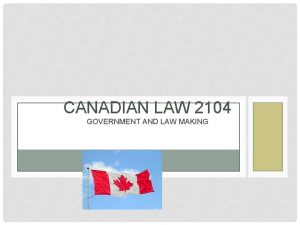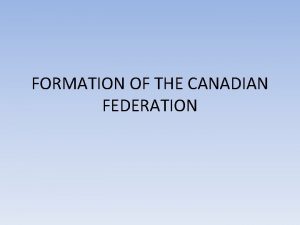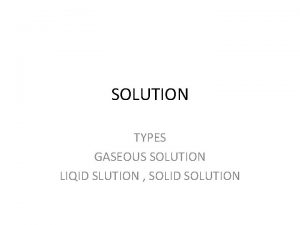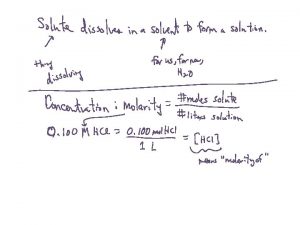Cardwells Law Canadian Innovation Solution to the Canadian


























- Slides: 26

Cardwell’s Law & Canadian Innovation Solution to the Canadian Paradox? Guy Stanley U of O Foresight Group Presentation 1

Cardwell’s Law (as cited by Joel Mokyr (1990) The Lever of Riches (Oxford))=“No nation has been technologically very creative for more than an historically short period”. (207—and 5 further references), (in reality “a crude empirical reality”). plus Mokyr (1994) Research Policy article) Explanation: in single countries, innovation evolves to the point that an innovation. Stanley U of O Foresight Group absorbing barrier. Guyto technological progress Presentation 2

The Canadian Innovation Paradox Canada’s S&T outranks that of many innovative countries. Yet Canada has few if any comparative advantages in high technology products. This after 20 years of innovation initiatives (1987 -2007) and more than C$400 Billion in R&D spending (cumulative). Guy Stanley U of O Foresight Group Presentation 3

Guy Stanley of O Foresight Source: U INSEAD 2010 Group Presentation 4

Table: Canada Major RCA with Rest of World (from OECD STAN Bilateral Trade Indicators 2008) Industry RCA Fertilizers 3. 3 Live Animals 4. 5 Wood Pulp 3. 3 Wood & Wood Products 5. 8 Nickel 6. 8 Zinc 3. 2 Guy Stanley U of O Foresight Group Presentation 5

Table: Canada –US RCA in Advanced Technology Products Industry Canada US Civil aviation 1. 47 4. 17 Precision instruments . 03 1. 6 Radio, TV and communication 0. 4 1. 3 Office and computing equipment 0. 3 1. 4 Pharmaceuticals 0. 5 0. 96 Guy Stanley U of O Foresight Group Presentation 6

Table : Innovation Rank and Selected Broad Performance Indicators (GCR 08 -09) Finland Japan Canada Innovation Rank 2 4 13 Quality of Scientific Institutions 11 15 4 FDI & Tech Transfer 22 36 7 Financial Sophistication 18 48 6 Regulatory Burden 12 9 40 Use of Mobile Phones 18 52 75 Internet Use 18 32 6 Use of PCs 22 26 1 Guy Stanley U of O Foresight Group Presentation 7

Table : Innovation Capacity Rank and Selected Business Innovation Indicators (GCR 08 -09) Finland Japan Canada Innovation Cap Rank 1 2 18 Company Spending on R&D (BERD) 9 2 22 University-Industry Research Collaboration 4 21 14 Utility Patents 4 3 10 Firm Level Tech Absorption 8 2 18 Guy Stanley U of O Foresight Group Presentation 8

Current explanations The explanation of choice arising from the CCA’s study last year is (principally) that Canadian business underfunds R&D and In particular, Canadian companies are slow to adopt strategies that depend on innovation for success. This is not really an explanation. Rather it is a restatement of the problem. Instead, we need to examine the system with a view to identifying Guy Stanley U of O Foresight Group 9 & analyzing its endogenous Presentation barriers to

Guy Stanley U of O Foresight Group Presentation 10

R&D Intensity by Industry production (% gross output valued at current prices ) Country Industry 1999 2000 2001 2002 Canada Hi Tech 10. 4 10. 1 11. 9 11. 0 ICT 10. 9 11. 7 16. 7 14. 8 Hi Tech 10. 5 10. 7 11. 2 ICT 10. 3 11. 1 13. 9 12. 4 US Guy Stanley U of O Foresight Group Presentation 11

Table: National Innovation Systems: Selected Inputs and Outputs GERD (% GDP) BERD (%GERD) Triad Patent Families (per million pop) Scientific Publications (per million pop) HRST in workforce (%) Question: What accounts for Canada’s low BERD multiple —or high BERD multiple in other OECD countries? Canada 2. 02 46. 7 25. 4 783. 2 35. 6 US 2. 74 64. 9 55. 2 725. 6 32. 2 OECD 2. 41 62. 5 43. 9 573. 2 (EU 15) 29. 7 Guy Stanley U of O Foresight Group Presentation 12

Table: Selected Recent Achievements: Canadian S&T Patents Ranking in Core and Citing Papers (excluding US and Japan) Matches US in RCA in ICT patents (1. 03) ranking 9 th place. (Finland leads with 1. 66) 3 rd in environmental science Fuel Cell Patents: Same global share as France (3. 6%). Japan leads with 48. 4% 4 th in regenerative medicine Triadic Patents per million population: Ranks 19 th (see table above). Japan leads with 115 6 th in analytical chemistry Guy Stanley U of O Foresight Group Presentation 13

North American Innovation Geography (Patents/pop) Guy Stanley U of O Foresight Group Presentation 14

1993 -5 2003 -5 Foreign Ownership of domestic invention 24. 9% 32. 9% Domestic Invention with Foreign Co-inventors 19. 2% 27. 2% Guy Stanley U of O Foresight Group Presentation 15

Government funding matters Guy Stanley U of O Foresight Group Source: CCCA 2009 Presentation 16

A More Current Picture—TB Report 2010 Guy Stanley U of O Foresight Group Presentation 17

Canadian firms rely on US for innovation support Foreign Ownership provides convenient access to new technologies developed outside Canada and involves the technology community heavily in local adaptation of that technology to Canadian needs. Statistics Canada puts US affiliate spending on R&D in Canada at 22% of Canadian BERD, noting US controlled firms received 37% of their R&D funding from outside Canada. US foreign affiliates do approximately twice the amount of R&D performed by other MNEs in Canada. (Statistics Canada 2009 Industrial R&D Intentions 2008, p. 6 and table 5 -4). Canadian innovators overwhelmingly cooperate with US firms ahead of any other partner choice. The most recent Statistics Canada survey of innovative manufacturers in Canada shows that four times as many Canadian innovative manufacturing firms collaborate with plants in the US than with Canadian government labs, Guy Stanley U ofcolleges O Foresightand Group three times more than with Canadian technical institutes, twice 18 Presentation

Figure : The US in Canada’s Innovation System Global Demand : US absorbs 66% of Canadian advanced tech products. In 2006, Canada was the top US supplier of weapons, second in aerospace and third in computer software. Canada is the 2 nd largest destination for US high tech products after China, the largest for software and 3 rd largest for life sciences. (US National Science Board, science & Engineering Indicators 2008, OECD Stan ) Company system: US Firms perform 22 % of industrial research in Canada R&D, mostly local adaption. (Stat Can) Crossover patenting the norm: Canadians patent 3 times as much in the US as in Canada, the US patents in Canada about 3 times more than Canadians. Eight of top 10 patenting companies in Canada are US companies. (USPTO, CIPO) Policy Framework: (OECD STI Scoreboard 2009) GERD (%GDP 2007) Canada 1. 9 US 2. 7 OECD av. 2. 3 BERD (%Industry value added 2007) Canada 1. 3% US BERD 3. 1% OECD av. 2. 4% Intermediaries: Two-thirds of Canadian hi tech firms would rather partner with US firms than with university or govt labs. (Stat Can) IP Regime: Publicly funded research hard to transfer to private sector. Law and practice clearer in the US (Since Baye. Dole) Canadian Policy favours SMEs and growing industrial R&D at universities. US environment offers faster track to efficient company size. Canadian academics coauthor with US (43% of Canadian S&E article output). US NIH a major funder of Canadian science, CIAR Funds US leading researchers. Largest single source of retail investment in Canada is the US Guy Stanley U of O Foresight Group Presentation 19

Real Output per hour Worked-Business sector Canada as a percentage of US Level 1947 -2007 Guy Stanley U of O Foresight Group Presentation 20

Guy Stanley U of O Foresight Group Presentation 21

Endogenous Sources of Innovation Stagnation in Canada Rybczynski’s law and the natural resource boom (expanding sector approaching a cyclical top)= sets the relative value scale of investment capital. “Market for Lemons” structure of technology valuation in Canada. More favourable risk-reward profile in the US— less unfavourable to innovation than Canada if only because of the larger population of Guy Stanley U of O Foresight Group 22 innovators and supporters Presentation-- : moving to the US

Other endogenous barriers Stagnation in the health care system blocks significant change, such as move to patient centred services based on technology-intensive care in smaller clinics and doctors offices. Stagnation in Canada’s national security configuration, which is only just now beginning to open up but is way behind on tech intensity, interoperability, etc. Technical Stagnation in other major systems Stanley U of O Foresight Group electrical grid, 23 (such as telecom, Guyinfrastructure, Presentation

These barriers have models Mancur Olsen’s model of pressure group gridlock—most evident in health care; Stackleburg competition in large industry sectors (civil aviation, media, telecom, financial services. . . ) that might otherwise buy and deploy more technology. Guy Stanley U of O Foresight Group Presentation 24

Some Consequences for Canada’s Innovation Performance (1) Canada’s advanced technology RCAs are weak because –apart from the below OECD average public funding--Canadian advanced technology companies are obliged by the configuration of forces to compete in or with the US system in ways that transfer their locus of competitive development to the US. (2) Canadian companies that choose to compete on innovation are generally more involved with US and global markets than the Canadian Stanley U of O Foresight Group 25 market because Guy those are where the value Presentation

Solution: The Sovereign Power of Innovation Valuation Government must use (inter alia) its procurement power to unblock innovation barriers in technology market structure Key is to start or expand some companies with a mission to conquer some technology space which will be useful to government in fulfilment of its mission. Techniques for mission selection and mobilization of Guy support Stanley U of O (think Foresight Group. Finland) Presentation 26
 Mysite.socccd
Mysite.socccd Radical innovation vs disruptive innovation
Radical innovation vs disruptive innovation Newton's first law and second law and third law
Newton's first law and second law and third law Newton's first law
Newton's first law V=k/p
V=k/p Avogadro's law constant
Avogadro's law constant Understanding canadian law (clu3m)
Understanding canadian law (clu3m) Understanding canadian law (clu3m)
Understanding canadian law (clu3m) Immiscible
Immiscible Hát kết hợp bộ gõ cơ thể
Hát kết hợp bộ gõ cơ thể Lp html
Lp html Bổ thể
Bổ thể Tỉ lệ cơ thể trẻ em
Tỉ lệ cơ thể trẻ em Chó sói
Chó sói Tư thế worms-breton
Tư thế worms-breton Bài hát chúa yêu trần thế alleluia
Bài hát chúa yêu trần thế alleluia Môn thể thao bắt đầu bằng từ chạy
Môn thể thao bắt đầu bằng từ chạy Thế nào là hệ số cao nhất
Thế nào là hệ số cao nhất Các châu lục và đại dương trên thế giới
Các châu lục và đại dương trên thế giới Công thức tính thế năng
Công thức tính thế năng Trời xanh đây là của chúng ta thể thơ
Trời xanh đây là của chúng ta thể thơ Mật thư anh em như thể tay chân
Mật thư anh em như thể tay chân Phép trừ bù
Phép trừ bù độ dài liên kết
độ dài liên kết Các châu lục và đại dương trên thế giới
Các châu lục và đại dương trên thế giới Thể thơ truyền thống
Thể thơ truyền thống Quá trình desamine hóa có thể tạo ra
Quá trình desamine hóa có thể tạo ra

















































